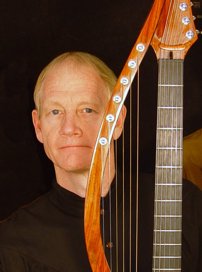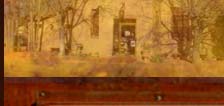


William Eaton
Finding Meaning in Strings
Friday, May 14, 7:30 PM
$12 advance, $15 door, $12 seniors
William Eaton Plays Handcrafted Stringed Instruments
Join William Eaton for a retrospective look at four decades of his music and instrument making on Friday, March 14, 7:30 PM at the Old Town Center for the Arts. This multi-faceted event will include music, images, and the stories behind the creation of William’s innovative stringed instruments. A co-founder and the current Director of Roberto-Venn School of Luthiery, a school for guitar making in Phoenix, William is acknowledged as one of the world’s great designers and builders of harp guitars and multi-stringed instruments. The concert will include insights into the inspiration, ideas, and construction of his instruments that, one reviewer said, “resemble ancient artifacts from the planet Pandora in Avatar.”
“This concert is a first for me,” William commented. “I’ll play 12 of my instruments, each with a different sound, shape and personality, including my latest instrument, the ‘Tree Harp’ that has strings attached to a bow shaped 18’ tree. I am fascinated with strings. In my daily observations I see strings attached to everything, and wonder what sound might be produced.”
For Eaton each instrument is a journey, requiring 6 months to 10 years to construct. From conception to completion to composing new music and playing these instruments, a story is revealed. As in oral tradition the story continues to unfold with each telling. Among the instruments that William will play and exhibit include: Elysian Harmonium, koto-harp guitar, lyre, O’ele’n Strings, Spiral Clef, vihuela, lyraharp guitar, Havasupai Harp, Tree Harp and double neck harp guitar. Each instrument is one-of-a-kind; unique in form, tonal qualities, woods, and materials. The designs draw inspiration from a diversity of world cultures and instrument families, and are as simple as the one string shaman’s bow to the technically complex double neck synthesizer harp guitar, complete with an onboard computerized Transperformance system, that allows strings to be tightened or loosened to predetermined pitches, instantaneously.
A three-time GRAMMY Nominee, Eaton has recorded 16 albums for the Phoenix based Canyon Records label, including seven collaborations with Native American flutist R. Carlos Nakai. Eaton has composed for and performed with the Amadeus Trio, Nouveau West Chamber Orchestra and the Nebraska Chamber Orchestra, as well as creating four albums with the “William Eaton Ensemble,” an eclectic “world chamber jazz” group that has charted in the top ten World Music charts in the U.S., Canada and Japan. Eaton’s background is eclectic. He was a champion pole vaulter and graduate of the year in the school of business at Arizona State University. He later earned an MBA degree from Stanford where he wrote the business plan for the Roberto-Venn School of Luthiery, a school he co-founded in 1975 with John Roberts and Robert Venn. Roberto-Venn School is the longest running guitar making school in the U.S. and has graduated over 2000 students from every continent except Antarctica. William has been an environmental advocate since the 70’s and is a founding board member of Sustainable Arizona.
Instrument Descriptions
Koto Harp Guitar (1978)
William’s first harp guitar design, renamed ‘koto harp guitar’ in 1998 when position stops were placed under the bottom bank of six harp strings. The stops are placed at harmonic intervals and the string can be played on either side of the stop, providing two pitches per string. The timbre and tuning of these strings resembles the sound of the Japanese ‘koto.’ The instrument is sculpted from curly burch, with a redwood sound plate, and elk antler frets, bridges, and nut.
Lyre (1981)
A variation on the ancient lyres played in hunting cultures, that used an animal skin stretched over a guord, tortoise shell or skull for a resonating cavity, and animal horns for a yoke that supports the strings. This instrument is sculpted from burled maple, utilizing a natural knot-hole for the sound hole.
Elysian Harmonium (1976)
The articulate writing on “sound and vibration” by Sufi sage, Hazrat Inyat Khan, inspired the creation of the Elesion Harmonium, 26 string guitar. The archetype symbol “olisk,” resembling the lotus petal, found throughout Indian art and architecture became the common form used in the body, headcap, bridge, sound hole, and tailpiece of this instrument.
Spruce top. Includes 6 double courses of strings, tuned in unison (both higher octave), except for the G strings, tuned an octave apart. Two sets of 7 strings are attached to the perimeter trim, and tuned with zither pins.
O'ele'n Strings (1982)
The shape of this instrument comes from the symbol on an antique armoire, and the extrapolation of the logarithmic growth and expression of plant leaves. The instrument is designed to play raga melodies and rhythms and the fretboards are scalloped to accommodate pitch bending. The name of the instrument: O’ele’n is derived from two words, octave and eleven. Octave is used to signify cycles and the ‘law of octaves’ in music and in Georges Gurdjieff’s mathematical cosmology. The number 11 recurs, with 11 courses of strings on each symmetrical half of the instrument, 11 strings below the bridge, 11 panel plates make up the unique three cavity multi-arched back. Made from walnut and ebony, with brass trim and inlay in the sound holes, bridge and nuts.
Electric Harp Guitar (2006)
The 18-string electric harp guitar has an extended guitar scale neck that is approximately two inches longer than a regular electric guitar. This longer scale gives the instrument a lower range and deeper tone values. A sinewy curve arches from the headstock to the end of the fret board and flows through the sculpted body to create harp bows by which to attach two extra sets of strings.
Spiral Clef (1985)
This instrument took its form from combining a treble clef and spiral. Three banks of strings allow low, mid, and high frequencies to be played. The bottom two strings on the playing neck use a ‘jawori’ style bridge that creates a buzz similar to the Indian sitar. Made from one piece of quilted flame maple. Inlay circle of brass with magnetized iron loads (brass plated) used for hand wound pickups by Eaton.
Lyraharp Guitar, Electric Harp Guitar, Double-Neck Harp Guitar (1995-2008)
Studies into indigenous shamanic experience and the use of the “spirit catcher” or shaman’s bow led to a series of instrument designs; including the lyraharp guitar, electric harp guitar (quartet set), and double neck electric harp guitar. The form of the shaman’s bow or hunter’s singing bow became the structural form for the extended “harp” strings, morphing into contemporary hybrid versions that include fretted guitar necks. Some compositions on these instruments employ repetitive entrainment, as used on the shaman’s bow to induce a trance like “altered” state, whereby the boundaries of normal perception are dissolved.
Tree Harp (2010)
The ‘Tree Harp’ is made from a bow shaped 18 foot ‘paradise’ tree, and has three sets of piano strings ranging from 16’ in length to 3.’ The longer strings produce subsonic frequencies.
Havasupai Harp (2007)
Made from a piece of mesquite driftwood found on a hike in Havasupai Canyon.
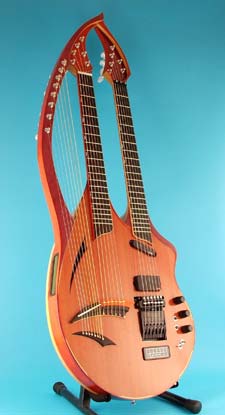
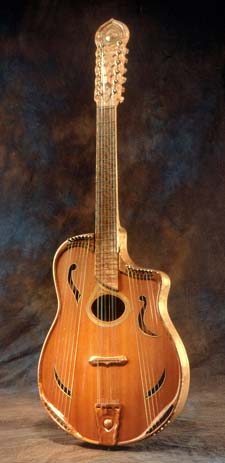
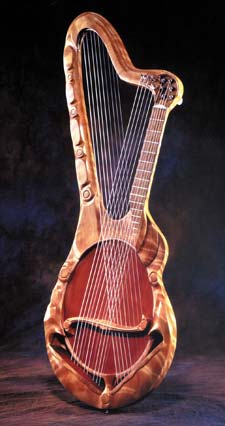
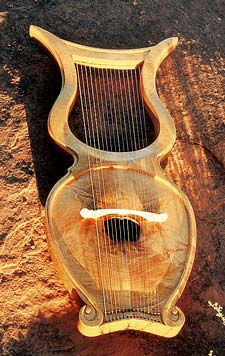
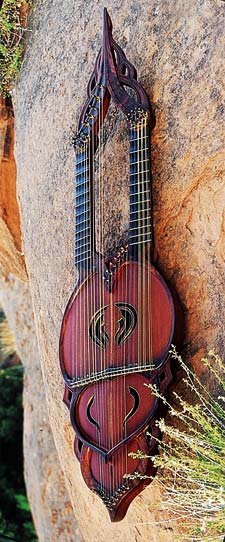
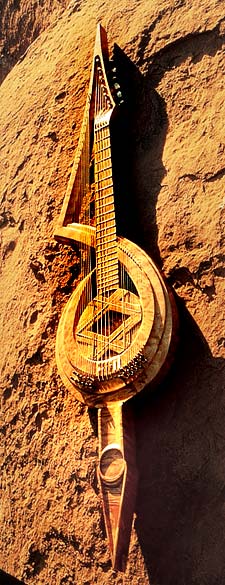
Home Events Tickets Theater Studio B Classes Cafe Map Links Contact
all content & design copyright © 2009 Old Town Center for the Arts all rights reserved
